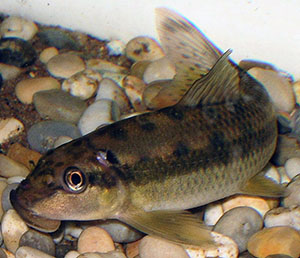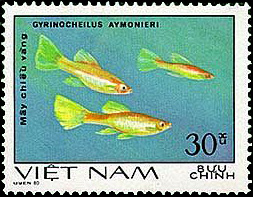
(Da: en.wikipedia.org)
Phylum: Chordata Haeckel, 1874
Subphylum: VertebrataLamarck J-B., 1801
Classe: Actinopterygii Klein, 1885
Ordine: Cypriniformes Bleeker, 1859
Famiglia: Gyrinocheilidae Gill T.N., 1905
Genere: Gyrinocheilus Vaillant, 1902
Italiano: Pulivetro, Mangiatore d'alghe cinese
English: Chinese algae-eater
Deutsch: Siamesische Saugschmerle
Descrizione
È stato registrato che G. aymonieri raggiunge almeno 28 cm ed è l'unica specie del genere ad avere 9 raggi dorsali ramificati e 36-40 scaglie di linea laterale. La bocca è inferiore con una speciale modifica a "ventosa" che consente al pesce di attaccarsi a superfici lisce. Non sono presenti barbigli. Il colore del tipo selvatico varia dal grigio chiaro all'oliva, con segni più scuri lungo la linea laterale che variano da una striscia piena con estensioni alternate superiori e inferiori a punti irregolari. La pancia è solitamente più chiara del colore di base. Alcuni segni più scuri possono anche essere osservati lungo la schiena e sulla pinna caudale, ma non si trovano segni scuri sulle pinne pelviche e anali. Il nome scientifico commemora il linguista ed esploratore francese Étienne Aymonier.
Diffusione
Si trova nel bacino del Chao Phraya, nel nord della penisola malese, nel bacino del Mekong (in Cambogia, nella provincia dello Yunnan in Cina, Laos, Tailandia e Vietnam), nel bacino del Mae Klong e nel fiume Xe Bang Fai. È più spesso visto nei grandi fiumi, occasionalmente entrando in campi allagati. Il pesce trascorre la maggior parte del tempo su superfici piane, come rocce, in acqua corrente, usando la sua bocca inferiore insolitamente formata per attaccarsi alle rocce in flussi più forti.
Sinonimi
= Psilorhynchus aymonieri Tirant, 1883.
Bibliografia
–Vidthayanon, C. (2012). "Gyrinocheilus aymonieri (Honey Sucker, Sucking 'Loach')". IUCN Red List of Threatened Species. 2012. Retrieved 25 February 2015.
–Kottelat, Maurice (July 1998). "Fishes of the Nam Theun and Xe Bangfai basins, Laos, with diagnoses of 22 new species (Teleostei: Cyprinidae, Balitoridae, Cobitidae, Coiidae and Odontobutidae)". Ichthyological Exploration of Freshwaters. 9 (1): 1-128.
–Froese, Rainer and Pauly, Daniel, eds. (2015). "Gyrinocheilus aymonieri" in FishBase. August 2015 version.
–Eschmeyer, W. N. and R. Fricke (eds) (2 November 2015). "Catalog of Fishes". California Academy of Sciences. Retrieved 13 November 2015.
–Taki, Y. (1978). "An analytical study of the fish fauna of the Mekong basin as a biological production system in nature". Research Institute of Evolutionary Biology Special Publications. 1: 77.
–Rainboth, Walter J. (1996). Fishes of the Cambodian Mekong. Rome: FAO (Food and agriculture organization of the United Nations). p. 265.
–Quoting Kottelat (1998): "Distinguished from the other species of the genus in having 9 branched dorsal rays, 36-40 lateral line scales and no dark spots on pelvic and anal fins. Size up to at least 280 mm SL".
–Frank, Neil; Liisa Sarakontu. "Algae Eating Cyprinids from Thailand and Neighboring Areas". The Aquatic Gardener: Journal of the Aquatic Gardeners Association. Aquatic Gardeners Association. Archived from the original on 2011-10-10.
–Order CYPRINIFORMES: Families PSILORHYNCHIDAE, GYRINOCHEILIDAE and CATOSTOMIDAE Archived 2016-05-12 at the Wayback Machine The ETYFish Project.
–"Spawning Chinese Algae Eater (Gyrinocheilus aymonieri)". Retrieved 24 October 2011.
–"How to keep Chinese algae eaters, Gyrinocheilus aymonieri, with pictures". Aqualand Pets Plus. 2006. Retrieved 2010-11-09. Sexing: Males develop breeding “horns” on their heads. Females get heftier.
–"Chinese Algae Eater, Gyrinocheilus aymonieri" (PDF). PETCO Animal Supplies, Inc. 2004. Archived from the original (PDF) on 2011-07-15. Retrieved 2010-11-09.

|
Data: 15/01/1981
Emissione: Ittiofauna Stato: Vietnam Republic |
|---|

